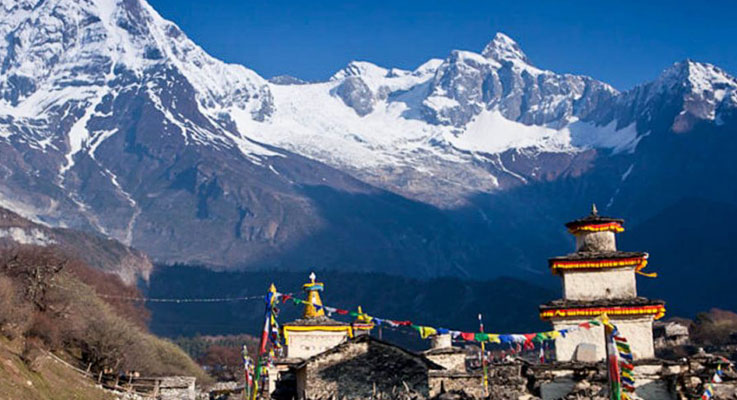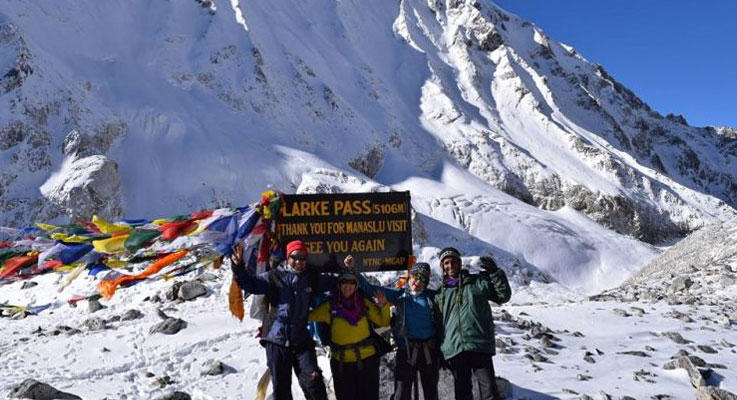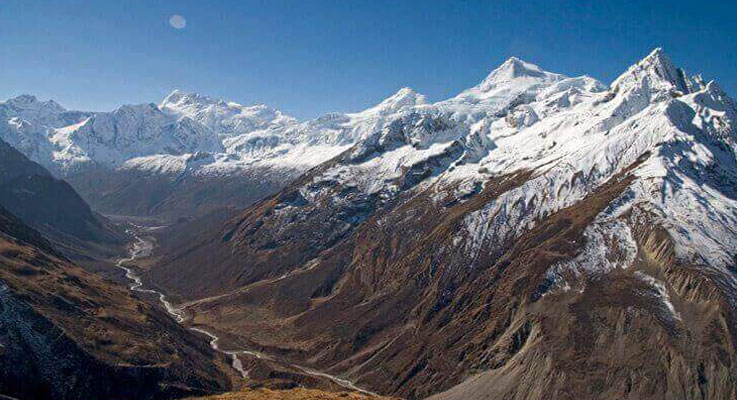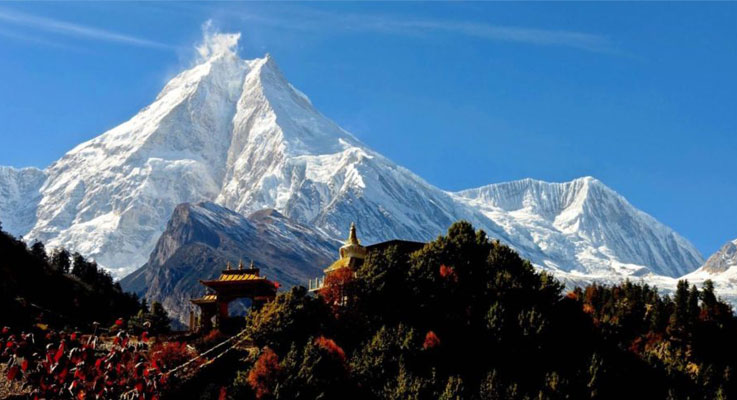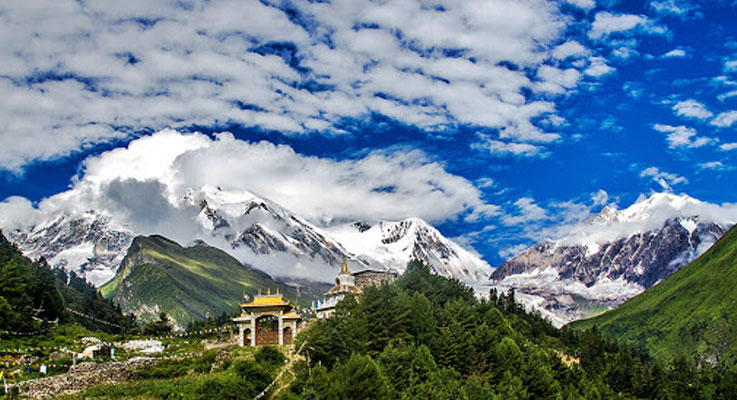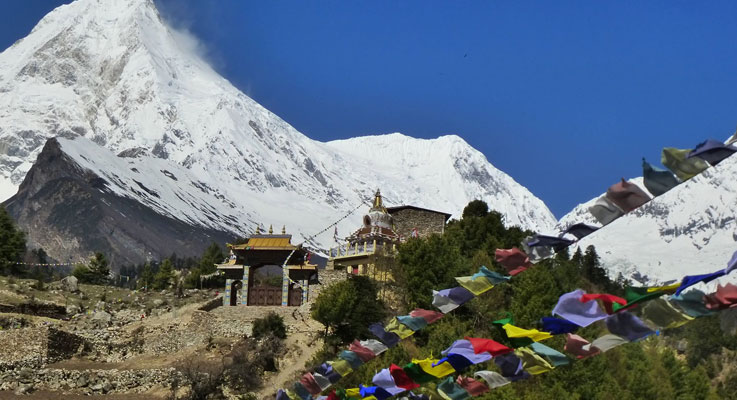-
Day 1
Arrival in Kathmandu (1,345m/4,413 ft)
Upon arriving at at Tribhuwan International Airport in Kathmandu, you will be received by our airport representatives who will warmly greet you and transfer to the hotel on a private tourist vehicle. We provide 3-star accommodation in the city and we arrange for a trip briefing with dinner in the evening.
-
Day 2
Visit old town of Kathmandu
A professional guide and vehicle are provided for a day of sightseeing in and around Kathmandu city. We visit some of the UNESCO World Heritage Sites in the city along with other interesting cultural monuments that dot the valley. These include Boudhanath Stupa (the largest Buddhist shrines in the world), Pashupatinath (the holiest Hindu temple in the world), Durbar Squares (Palaces and fortresses of medieval Kings), along with other popular cultural attractions. We get to observe the lifestyle of Nepalese people, holy sadhus and monks, fascinating history as well as awe-inspiring architecture.
-
Day 3
Drive from Kathmandu to Arughat (640m / 2,100ft)
We take an 8-9 hrs bus ride to Arughat Bazaar in Gorkha district. The village of Arughat is in two parts, on opposite sides of the Buri Gandaki. Arughat Bazaar is large, clean and prosperous with hotels and shops selling cloth, food and hardware.
-
Day 4
Trek from Arughat to Soti Khola (775m / 2,543ft)
From Arughat Bazar we trek to Soti Khola. Along the way we enjoy splendid views of Shringri Himal. We trek through Gurung and Magar villages, past fields and cascading waterfalls, till we reach Soti Khola.We set up camp on the banks of the Soti Khola(‘khola' means river in Nepali).
-
Day 5
Trek from Soti Khola to Machha Khola (900m / 2,953ft)
We trek from Soti Khola to Machha khola (Fish river). Machha khola is a village situated above a stream with the same name. We camp for the night by a wide campsite.
-
Day 6
Trek from Machha Khola to Doban
The trail from Macha Khola to Doban involves some steep ascents and descents. We climb a well – crafted staircase over a ridge to Doban. Doban lies at the confluence of the Shiar Khola, which flows from the east, and the Sarpu khola, which flows from the west.
-
Day 7
Trek from Doban to Philim
The route climbs ona rugged rocky trail. We climb up and down ravines and notched trees. We get good views of Sringri himal as we continue up to the village of Philim at 1550m.This is a large Gurung village with fields of corn and millet. There are several good campsites and we set up camp surrounded by alder, blue pine and poplar trees.
-
Day 8
Trek from Philim to Chumling (Lower Tsum)
We take the trail up through Philim and head up over a ridge that leads to Ganesh Himal Base camp and Chumling( Lower Tsum). We camp for the night at Chumling. There are several good campsites at Chumling.
-
Day 9
Chumling to Chhokangparo (Upper Tsum)
From Chumling we trek to Chhokangparo. Upper Tsum valley (part of the Inner Himalaya) open from Chhokangparo.Chhekamparo is a village situated on flat land and made up of two settlements Chhekam and Paro. From the valley, the Ganesh Himal range can be seen directly to the south where it provides spectacular views of the Baudha and Himal chuli peaks to the south-west. Some households in this village practice polyandry.
-
Day 10
Trek from Chhokangparo to Nile/Chhule
From Chhokangparo we trek to Nile/ Chulle. This is the last village heading north in the upper Tsum Valley. Nile is on the western, sun-side of the Shiar Khola, about 20 minutes walk across from Chhule. On the way we pass the Piren Phu cave. Piren Phu (pigeon cave) is one of the most sacred caves in the Tsum valley. It is located at the foot of a rugged cliff near the village of Burji. Milarepa, the famous Tibetan saint, was believed to have meditated here. There are two separate gumbas attached to the rocky cave. Richly painted Buddhist murals, excellent artistic scripts carved on stones, long prayer flags and significant Buddhists paper scripts make this cave one of the most important socio-cultural asset in the valley. Beautiful views can be had of the Shiar Khola, Rachen Gumba, the mountains and settlements amidst vast agricultural land.
-
Day 11
Nile/Chhule to Mu Gompa
From Nile the trail gradually ascends to Mu gumba, the largest monastery in the region. Mu Gumba is located at the highest and farthest point in the Tsum valley. Mu Gumba was established in 1895 AD and is situated at an altitude of 3510m.The monastery houses religious books, including Kangyur, a life sized statue of Avalokiteshwara, and images of Guru Padmasambhava and Tara. Dephyudonma Gumba is one of the oldest monasteries in the Tsum Valley and is situated in the rugged mountains, a 2 hr walk from the village of Chhule and Nile. The history of this monastery is directly associated with the dawn of Buddhism in the valley. The monastery is run by Lama Serap of Nile Ladrang from the Kangin sect. There are a few campsites and drinking water facilities.
-
Day 12
Extra day for excursion
We take a hike up Mu Gumba and reach the base of Pika Himal (4865m).We are quite close to Tibet and get a good view of the Tibetan peaks as well as the Ganesh Himal range. After the day's excursion we return to our camp at Mu gumba.
-
Day 13
Mu Gompa to Rachen Gompa
From Mu Gumba we take the trail to Rachen Gumba, a nunnery. The nunnery is situated in the Shiar Khola Valley in the foothills of the mountains bordering Nepal and Tibet. Rachen Gumba was established in the year 1905 AD and is one of the largest nunneries in the Tsum valley. It houses nuns belonging to the Ngak-pa sect, which does not allow animal slaughter. The nunnery houses one thousand clay, moulded statues of Avalokiteshwara, a brightly colored, carved throne and pillar, and a large prayer wheel. The interior is richly painted with murals about Buddhism and its history.
-
Day 14
Rachen Gompa to Dumje
From Rachen Gompa we proceed towards Dumje, a small village with about eight houses and adjoining cattle shed.
-
Day 15
Dumje to Philim (cross Ripchet)
From Dumje we trek to Philim and cross Ripchet. On the way we pass one of the most beautiful waterfalls in the Lower Tsum Valley, Samba Tingding Chhupyang.
-
Day 16
Philim to Tatopani
From Phillim we trek to Tatopani. There is a hot spring at Tatopani. You can relieve your tired muscles by soaking yourself in the hot spring.
-
Day 17
Tatopani to Soti Khola (775m / 2,543ft)
From Tatopani we trek to Soti Khola. We pass through terraced fields and tropical waterfalls and finally set up camp at the village.
-
Day 18
Soti Khola to Arughat Bazar (640m / 2,100ft)
As we make our way from Soti Khola to Arughat Bazar, we come to the last leg of our journey.
-
Day 19
Drive from Arughat Bazar to Kathmandu (1,345m/4,413 ft)
We drive to Kathmandu on the national highway running parallel to the gorgeous Trishuli River. With gorgeous views of the hills, farms, mountains and river along the way, the drive is very picturesque and you can also observe the daily lives of Nepalese people on the way.
-
Day 20
Leisure day in Kathmandu
Today will be leisure and rest day. You are free to go souvenir shopping, spa and more exploration of the city, or extend your trip to include bungee jumping, rafting, mountain biking, Everest mountain flight and other adventurous activities. In the evening, we will have a farewell dinner at Mul Chowk Restaurant’s cozy and elegant dining ambience.
-
Day 21
Departure from Nepal
The trip concludes today. You will be dropped at Kathmandu's Tribhuwan International Airport by our airport representative for your flight departure from Nepal.

